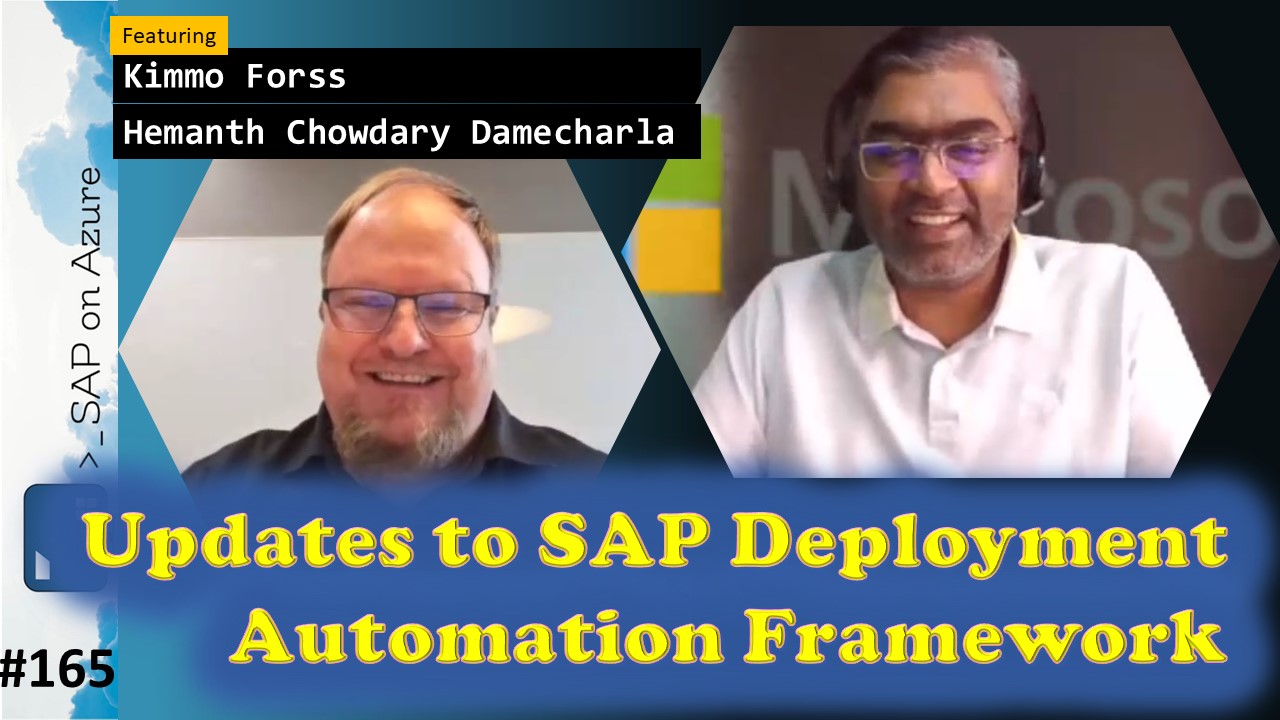Configuration Editor with SAP Deployment Automation Framework
| Kimmo Forss | Hemanth Chowdary Damecharla |
Episode #165
Introduction
In episode 165 of our SAP on Azure video podcast we talk about SAP HANA on Azure Large Instances will be retired by 30 June 2025 and the transition to Virtual Machines, Configuring Azure NetApp Files (ANF) Application Volume Group (AVG) for zonal SAP HANA deployment, Changes to the Azure reservation exchange policy, a look back at the ABAP Story, A Cool use of Open AI in Eclipse, Microsoft Business Applications Launch Event introduces wave of new AI-powered capabilities for Dynamics 365 and Power Platform and Azure OpenAI powered SAP Self-Services.
Then we take a closer look at SDAF, or the SAP Deployment Automation Framework, which started as nice tool to simplify the deployment of SAP systems in a consistent and repeatable way. In the meantime SDAF has grown into a huge project, is leveraged by the Azure Center for SAP Solution and actually by lots of partners and customers. Kimmo Forss and Hemanth Damecharla show us the latest features, like the Configuration Editor and the integration in Azure DevOps
Find all the links mentioned here: https://www.saponazurepodcast.de/episode165
Reach out to us for any feedback / questions:
- Robert Boban: https://www.linkedin.com/in/rboban/
- Goran Condric: https://www.linkedin.com/in/gorancondric/
- Holger Bruchelt: https://www.linkedin.com/in/holger-bruchelt/
#Microsoft #SAP #Azure #SAPonAzure #SDAF #Infrastructure
Summary created by AI
Key Topics:
- News from the weekend: The team shared some news about Azure VMs, reserved instances, exchange policy, and SAP on Azure video podcast.
- Introduction of Kimmo and Hemanth: Kimmo and Hemanth are part of the SAP on Azure development team based in Helsinki, Finland, working on the SAP Deployment Automation Framework.
- Overview of SAP Deployment Automation Framework: The framework is an open source tool that helps customers deploy and configure SAP systems on Azure using Terraform and Ansible, with a modular and extensible design.
- New features and demos of the framework: The team showed some new features and demos of the framework, such as the configuration editor, the application service, the private DNS, the application manifest, and the software download.
- Questions and feedback: The team answered some questions and feedback from the audience, such as the support for different SAP versions and platforms, the open source contribution model, the validation and testing process, and the deployment time and complexity.
- SAP HANA on Azure Large Instances will be retired by 30 June 2025 – transition to Virtual Machines
- Configuring Azure NetApp Files (ANF) Application Volume Group (AVG) for zonal SAP HANA deployment
- Changes to the Azure reservation exchange policy
- YouTube: The ABAP Story
- Changes to the Azure reservation exchange policy
- Microsoft Business Applications Launch Event introduces wave of new AI-powered capabilities for Dynamics 365 and Power Platform
- Azure OpenAI powered SAP Self-Services
- SAP Deployment Automation Framework
- 0:00 Intro
- 1:15 SAP HANA on Azure Large Instances will be retired by 30 June 2025 – transition to Virtual Machines
- 2:50 Configuring Azure NetApp Files (ANF) Application Volume Group (AVG) for zonal SAP HANA deployment
- 5:00 Changes to the Azure reservation exchange policy
- 7:05 YouTube - The ABAP Story
- 7:45 A Cool use of Open AI in Eclipse
- 8:55 Microsoft Business Applications Launch Event introduces wave of new AI-powered capabilities for Dynamics 365 and Power Platform
- 10:05 Azure OpenAI powered SAP Self-Services
- 10:50 Introducing Kimmo and Hemanth
- 12:30 Overview of SAP Deployment Automation Framework
- 14:10 Azure Center for SAP Solutions
- 14:45 Architecture of SDAF
- 20:30 Evolution of SDAF | Execution Maturity
- 26:00 Demo Configuration Editor
- 34:35 Create a pipeline in Azure DevOps
- 38:00 How-to guides
- 42:20 Configuration as Code with Azure DevOps
- 48:15 Available Resources
- 48:55 Bill of material - the application manifest
